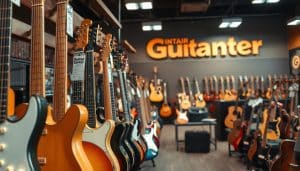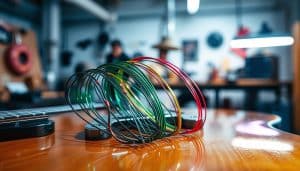If you’re a guitar enthusiast looking to take your playing to the next level, finding the best guitar compressor pedal is essential. This comprehensive guide will walk you through everything you need to know about compressor pedals, from how they work to the different types available. Whether you’re a beginner or a seasoned musician, we’ve got you covered with expert tips and recommendations to help you find the perfect pedal to enhance your guitar sound and improve your overall playing experience. Get ready to unlock a world of limitless possibilities with the best guitar compressor pedal for your needs.

What is a Guitar Compressor Pedal?
Definition
A guitar compressor pedal is a device that is used to control the dynamic range of the guitar’s signal. It essentially squeezes the louder parts of the signal and boosts the quieter parts, resulting in a more even and balanced sound. This is achieved by compressing the dynamic range, which is the difference between the loudest and softest parts of the guitar’s volume.
Purpose
The purpose of a guitar compressor pedal is to enhance the overall sound of the guitar by adding sustain, improving note clarity, and enhancing the attack of the notes. It is especially useful for guitarists who play genres that require a consistent and smooth sound, such as country, funk, and blues. Compressor pedals can also be used as a tool for shaping the tone and adding a unique character to the guitar’s sound.
Benefits
There are several benefits to using a guitar compressor pedal. First and foremost, it helps to even out the volume of the guitar, ensuring that the quieter notes can be heard without being drowned out by the louder ones. This can be particularly useful for solos or intricate fingerpicking patterns. Additionally, a compressor pedal can add sustain to the guitar’s notes, allowing them to ring out for longer periods of time. It also helps to control any unwanted noise or feedback, resulting in a cleaner and more professional sound. Lastly, many compressor pedals offer various controls and features that allow for a wide range of tonal possibilities, giving guitarists the ability to shape their sound to their liking.
Different Types of Guitar Compressor Pedals
Analog Compressor Pedals
Analog compressor pedals are known for their warm and organic sound. They use analog circuitry to compress the guitar’s signal, which can result in a more natural and vintage tone. Analog compressors typically offer simple controls, such as threshold, ratio, and gain, making them easy to use and understand. Many guitarists prefer analog compressors for their simplicity and classic sound.
Digital Compressor Pedals
Digital compressor pedals, on the other hand, use digital processing to compress the guitar’s signal. They offer more advanced features and controls, allowing for greater precision and flexibility. Digital compressors often include presets, multiple compression modes, and additional effects, such as EQ and modulation. They are favored by guitarists who require a high level of control and versatility in their compressor pedals.
Tube Compressor Pedals
Tube compressor pedals are designed to emulate the sound of vintage tube compressors. They use vacuum tubes in their circuitry, which can add warmth and character to the guitar’s sound. Tube compressors are often sought after for their smooth compression and musicality. They can be a great choice for guitarists who want that classic tube sound in a pedal format.
Optical Compressor Pedals
Optical compressors use a light source and a photocell to control the level of compression. They are known for their transparent and natural sound. Optical compressors are especially effective at evening out the dynamics of the guitar’s signal without coloring the tone too much. They are often used by guitarists who value subtlety and transparency in their compression.

Factors to Consider Before Buying a Guitar Compressor Pedal
Budget
One of the first things to consider before buying a guitar compressor pedal is your budget. Compressor pedals come in a wide range of prices, so it’s important to determine how much you are willing to spend. Keep in mind that higher-priced pedals often offer more advanced features and better build quality, but there are also affordable options that can deliver great results.
Type of Music
The type of music you play is another important factor to consider. Different genres and playing styles may require different types of compression. For example, if you play country or funk, you may prefer a compressor pedal that can provide a strong and percussive attack. On the other hand, if you play blues or classic rock, you may prioritize sustain and smoothness in your compression.
Level of Experience
Your level of experience as a guitarist can also influence your choice of a compressor pedal. If you’re a beginner, you may want to start with a pedal that offers simple controls and is easy to use. As you gain more experience and knowledge, you may want to explore pedals with more advanced features that allow for greater control and experimentation.
Quality and Durability
The quality and durability of the pedal are important considerations, especially if you plan on using it regularly or taking it on gigs. Look for pedals that are well-built and made with high-quality components. Reading customer reviews and checking the reputation of the brand can also give you an idea of the pedal’s reliability and longevity.
Controls and Features
Consider the controls and features that are important to you. Some compressor pedals offer only basic controls, such as threshold and ratio, while others provide a wide range of parameters to adjust, such as attack, release, blend, and side-chain filtering. Think about the specific sounds and effects you want to achieve and choose a pedal that offers the necessary controls to achieve them.
Power Options
Lastly, consider the power options of the compressor pedal. Most pedals can be powered with a 9V battery or an external power supply. Some pedals also offer the option of being powered by an AC adapter or a USB connection. Think about how you plan on using the pedal and choose a power option that is convenient and reliable for you.
Key Features to Look for in a Guitar Compressor Pedal
Threshold Control
The threshold control determines the level at which the compressor starts to kick in. It allows you to set the point at which the compressor begins reducing the volume of the guitar’s signal. Look for a pedal that offers a threshold control that suits your playing style and dynamics.
Ratio Control
The ratio control determines the amount of compression that is applied to the guitar’s signal. It allows you to adjust the intensity of the compression. Higher ratios result in more pronounced compression, while lower ratios provide a more subtle effect. Consider the desired level of compression and choose a pedal with a ratio control that suits your needs.
Attack and Release Controls
The attack control determines how quickly the compressor responds to the incoming signal. A fast attack time can result in a more percussive and aggressive compression, while a slower attack time can allow the initial transient of the notes to come through. The release control determines how quickly the compressor stops compressing after the signal falls below the threshold. It affects the sustain and release of the notes. Look for a pedal that offers adjustable attack and release times to achieve the desired effect.
Make-up Gain
The make-up gain control allows you to compensate for any volume loss that occurs during compression. It allows you to increase the overall output level to match the uncompressed signal. This is especially useful for maintaining a consistent volume when using a high level of compression. Look for a pedal that offers a make-up gain control that is easy to adjust.
Side-chain Filter
Some compressor pedals offer a side-chain filter, which allows you to shape the compression based on the frequency content of the guitar’s signal. It can be used to emphasize or de-emphasize certain frequencies, resulting in more targeted compression. Consider whether a side-chain filter is important to you and choose a pedal that offers this feature if needed.
Blend Function
A blend function allows you to mix the compressed signal with the dry (uncompressed) signal. This can be useful for maintaining the dynamics and attack of the original signal while still benefiting from the compression. Look for a pedal that offers a blend function if you want to retain some of the natural dynamics of your playing.
Bypass Options
Consider the bypass options offered by the compressor pedal. Most pedals offer a standard true bypass, which completely bypasses the pedal when it’s not in use. Some pedals also offer buffered bypass, which can help maintain the high-frequency response and prevent signal degradation when using long cable runs or multiple pedals. Choose a bypass option that suits your setup and preferences.
LED Indicator
An LED indicator can be a handy feature that allows you to visually monitor the compression and adjust the settings accordingly. It provides a visual representation of how much compression is being applied and can help you dial in the desired effect. Look for a pedal that offers a clear and easy-to-read LED indicator.
Input/Output Options
Consider the input and output options of the compressor pedal. Most pedals offer a standard mono input and output, which are suitable for most setups. However, if you want to use stereo effects or connect the pedal to multiple amps or devices, look for a pedal that offers stereo inputs and outputs.
Build Quality
The build quality of the pedal is an important consideration, especially if you plan on using it frequently or taking it on the road. Look for a pedal that is well-built and made with high-quality materials. Check customer reviews and the brand’s reputation to ensure that the pedal is reliable and durable.

Top Brands in Guitar Compressor Pedals
When it comes to guitar compressor pedals, there are several top brands that are known for their quality and innovation. These brands have built a reputation for producing reliable and great-sounding compressor pedals. Here are some of the top brands in the industry:
Boss
Boss is a well-known brand that offers a wide range of guitar pedals, including compressor pedals. Their pedals are known for their durability, reliability, and user-friendly design. The Boss CS-3 is a popular choice among guitarists looking for a versatile and affordable compressor pedal.
MXR
MXR is another reputable brand that is highly regarded for its compressor pedals. They offer a range of options, from simple and straightforward pedals to more advanced and feature-packed models. The MXR Dyna Comp is a classic compressor pedal that has been used by countless guitarists for its distinctive sound and ease of use.
Keeley
Keeley is a boutique pedal manufacturer known for its high-quality and handcrafted pedals. Their compressor pedals are highly regarded for their transparency and versatility. The Keeley Compressor Plus is a popular choice among guitarists looking for a compressor pedal that can deliver a wide range of compression tones.
Wampler
Wampler is a brand that is known for its high-quality and versatile pedals. Their compressor pedals are praised for their transparency and ease of use. The Wampler Ego Compressor is a favorite among many guitarists for its ability to provide smooth and natural compression.
Xotic
Xotic is a brand that is renowned for its premium pedals and exceptional sound quality. Their compressor pedals are highly regarded for their transparency and flexibility. The Xotic SP Compressor is a popular choice for its ability to deliver studio-quality compression in a compact pedal format.
Empress
Empress is a Canadian brand that is known for its innovative and feature-rich pedals. Their compressor pedals are highly regarded for their versatility and advanced control options. The Empress Compressor is a top choice for guitarists who want a compressor pedal that offers a wide range of tonal possibilities.
Strymon
Strymon is a brand that is synonymous with high-quality and cutting-edge technology. Their compressor pedals are praised for their pristine sound quality and extensive control options. The Strymon OB.1 is a popular choice for its studio-quality compression and added EQ and boost functions.
Diamond
Diamond is a boutique pedal manufacturer known for its exceptional build quality and sound. Their compressor pedals are highly regarded for their transparency and musicality. The Diamond Compressor is a favorite among many guitarists for its ability to enhance their tone without sacrificing dynamics.
TC Electronic
TC Electronic is a brand that offers a wide range of guitar pedals, including compressor pedals. Their pedals are known for their versatility and affordability. The TC Electronic HyperGravity is a popular choice among guitarists for its ability to provide a wide range of compression tones and its intuitive controls.
JHS
JHS is a brand that is known for its high-quality and handcrafted pedals. Their compressor pedals are highly regarded for their transparency and versatility. The JHS Pulp ‘N’ Peel V4 is a popular choice for its ability to deliver smooth and musical compression in a compact and user-friendly package.
Popular Guitar Compressor Pedals on the Market
With so many options available on the market, it can be overwhelming to choose the right guitar compressor pedal for your needs. To help you get started, here are some popular compressor pedals that are widely recommended by guitarists:
Boss CS-3
The Boss CS-3 is a classic compressor pedal that offers a wide range of compression tones. It features adjustable controls for sustain, tone, and level, allowing for easy customization of the compression effect. The CS-3 is known for its affordability and durability, making it a popular choice for beginners and professionals alike.
MXR Dyna Comp
The MXR Dyna Comp is a legendary compressor pedal that has been used by countless guitarists. It is known for its simple and straightforward design, with only two knobs for output and sensitivity control. The Dyna Comp provides a subtle and smooth compression that enhances the sustain and attack of the guitar’s notes.
Keeley Compressor Plus
The Keeley Compressor Plus is a versatile compressor pedal that offers a wide range of compression options. It features controls for compression level, sustain, blend, and tone, allowing for precise adjustments to the compression effect. The Compressor Plus is hailed for its transparency and ability to retain the natural dynamics of the guitar.
Wampler Ego Compressor
The Wampler Ego Compressor is a highly regarded compressor pedal that provides transparent and musical compression. It features controls for sustain, attack, blend, and tone, allowing for easy customization of the compression effect. The Ego Compressor is loved for its ability to enhance the guitar’s tone without sacrificing its natural dynamics.
Xotic SP Compressor
The Xotic SP Compressor is a compact and versatile compressor pedal that offers studio-quality compression. It features controls for blend, volume, compression, and a three-way toggle for various compression ratios. The SP Compressor is praised for its transparency and ability to deliver a wide range of compression tones.
Empress Compressor
The Empress Compressor is a feature-packed compressor pedal that offers extensive control options. It features controls for compression, mix, attack, and release, as well as a side-chain filter and a variable knee control. The Empress Compressor is highly regarded for its versatility and ability to shape the compression effect to suit various playing styles.
Strymon OB.1
The Strymon OB.1 is a premium compressor and clean boost pedal that offers studio-quality compression and EQ options. It features controls for compression, tone, and boost level, as well as a selectable high-pass filter. The OB.1 is known for its pristine sound quality and ability to add clarity and definition to the guitar’s signal.
Diamond Compressor
The Diamond Compressor is a boutique compressor pedal that is highly regarded for its transparency and musicality. It features controls for compression, ratio, volume, and attack. The Diamond Compressor is praised for its ability to enhance the guitar’s tone without sacrificing its natural dynamics, making it a favorite among many professional guitarists.
TC Electronic HyperGravity
The TC Electronic HyperGravity is a versatile compressor pedal that offers a wide range of compression options. It features controls for sustain, attack, blend, and level, as well as a three-way toggle for various compression modes. The HyperGravity is known for its affordability and ability to deliver professional-level compression tones.
JHS Pulp ‘N’ Peel V4
The JHS Pulp ‘N’ Peel V4 is a handcrafted compressor pedal that offers transparent and musical compression. It features controls for compression, EQ, blend, and volume, allowing for precise adjustments to the compression effect. The Pulp ‘N’ Peel V4 is highly regarded for its versatility and ability to deliver smooth and natural compression.

How to Use a Guitar Compressor Pedal
Using a guitar compressor pedal can greatly enhance your playing and tone. Here are some steps to help you effectively use a compressor pedal:
Setting the Threshold
Start by setting the threshold control. This determines the level at which the compressor starts reducing the volume of the guitar’s signal. Set the threshold to a point where the compressor kicks in when you play the harder notes, but not so much that it constantly compresses the signal.
Adjusting the Ratio
Next, adjust the ratio control to determine the amount of compression that is applied to the guitar’s signal. Higher ratios result in more pronounced compression, while lower ratios provide a more subtle effect. Experiment with different ratios to find the desired level of compression for your playing style.
Setting Attack and Release Times
Adjust the attack and release controls to shape the compression effect. The attack control determines how quickly the compressor responds to the incoming signal, while the release control determines how quickly the compressor stops compressing after the signal falls below the threshold. Experiment with different attack and release times to find the right balance that suits your playing style and the musical context.
Using the Make-up Gain
Use the make-up gain control to compensate for any volume loss that occurs during compression. Increase the make-up gain to match the output level of the uncompressed signal. This will help maintain a consistent volume and ensure that the compressed signal is balanced with the rest of your tone.
Utilizing Side-chain Filter
If your compressor pedal has a side-chain filter, experiment with it to shape the compression based on the frequency content of the guitar’s signal. Use the side-chain filter to emphasize or de-emphasize certain frequencies, resulting in a more targeted compression. This can help you achieve a more focused and balanced tone.
Blending Compressed and Dry Signals
If your compressor pedal has a blend function, consider using it to mix the compressed signal with the dry (uncompressed) signal. This can help maintain the dynamics and attack of the original signal while still benefiting from the compression. Experiment with different blend settings to find the right balance for your desired effect.
Choosing the Right Bypass Option
Consider the bypass options of your compressor pedal. Most pedals offer a standard true bypass, which completely bypasses the pedal when it’s not in use. Some pedals also offer buffered bypass, which can help maintain the high-frequency response and prevent signal degradation when using long cable runs or multiple pedals. Choose a bypass option that suits your setup and preferences.
Using LED Indicator to Monitor Compression
Utilize the LED indicator on your compressor pedal to visually monitor the compression and adjust the settings accordingly. The LED indicator provides a visual representation of how much compression is being applied, allowing you to fine-tune the effect to your liking. Keep an eye on the LED indicator as you play to ensure that the compression is working as desired.
Connecting to Other Pedals and Amps
Consider the placement of your compressor pedal in your signal chain. The compressor pedal can be placed either before or after other effects pedals, depending on the desired effect. Experiment with different placements to find the best position for your compressor pedal in your setup. Additionally, ensure that you are connecting your compressor pedal correctly to your amp and other pedals to get the best possible sound.
Tips and Tricks
- Experiment with different settings and parameters to find the right compression effect for your playing style and the musical context.
- Try using the compressor pedal in combination with other effects pedals to create unique and interesting sounds.
- Take the time to learn and understand the controls and features of your compressor pedal to get the most out of it.
- Utilize online resources, forums, and tutorials to learn more about compression techniques and how to use your compressor pedal effectively.
- Take your time to dial in the compression settings and make adjustments as needed, as every guitar and playing style may require different settings.
Common Mistakes to Avoid When Using a Guitar Compressor Pedal
Using a guitar compressor pedal can greatly enhance your playing, but it’s important to avoid some common mistakes that can negatively impact your tone. Here are some common mistakes to avoid when using a guitar compressor pedal:
Using Extreme Compression Settings
One common mistake is using extreme compression settings that result in an unnatural and squashed sound. While compression can be a powerful tool, it’s important to use it in moderation. Start with conservative compression settings and make adjustments based on your playing style and the musical context.
Neglecting to Adjust Attack and Release Times
Neglecting to adjust the attack and release times can result in an ineffective and unbalanced compression. These parameters greatly influence the feel and response of the compression effect. Take the time to dial in the attack and release times to achieve the desired sustain, attack, and release of the notes.
Not Adjusting the Make-up Gain
Forgetting to adjust the make-up gain can result in an inconsistent volume when using compression. The make-up gain compensates for any volume loss that occurs during compression. Be sure to increase the make-up gain to match the output level of the uncompressed signal.
Overusing the Compressor Pedal
Overusing the compressor pedal can lead to a compressed and lifeless tone. While compression can enhance your playing, it’s important to use it sparingly and when necessary. Consider the musical context and be mindful of the dynamics and feel of your playing.
Not Matching the Compressor with the Guitar and Amp
Using a compressor pedal that is not well-matched with your guitar and amp can result in undesirable tone and response. Different compressors have different characteristics and tonal qualities. Take the time to choose a compressor pedal that suits your guitar and amp to achieve the best possible sound.
Misplacing the Compressor Pedal in Signal Chain
The placement of the compressor pedal in your signal chain can greatly affect the overall tone and response. Placing the compressor pedal before other effects pedals can result in a different sound compared to placing it after. Experiment with different placements to find the best position for your compressor pedal in your setup.
Ignoring the Signal Chain Order
Ignoring the proper signal chain order can lead to signal degradation and unwanted noise. It’s important to follow the correct order of effects to ensure optimal performance and sound quality. Research and understand the recommended signal chain order for your setup and make the necessary adjustments.

How to Maintain and Care for Your Guitar Compressor Pedal
Taking proper care of your guitar compressor pedal can ensure its longevity and optimal performance. Here are some tips on how to maintain and care for your compressor pedal:
Cleaning the Pedal
Regularly clean the exterior of your compressor pedal using a soft, lint-free cloth. Wipe off any dust, fingerprints, or smudges that may accumulate over time. Avoid using harsh chemicals or abrasive materials that can damage the finish or controls.
Avoiding Excessive Heat and Moisture
Avoid exposing your compressor pedal to excessive heat and moisture, as this can damage the internal components. Store your pedal in a cool and dry place when not in use. If you’re playing in a humid environment, consider using a dehumidifier or storing your pedal in a protective case.
Checking and Replacing Batteries
If your compressor pedal is battery-powered, regularly check the battery to ensure that it has enough power. Replace the battery when it is low or not functioning properly. Consider using a rechargeable battery or an external power supply for convenience and to avoid reliance on disposable batteries.
Inspecting and Repairing Cables
Regularly inspect the cables that connect your compressor pedal to your guitar and amp. Look for any frayed wires, loose connections, or other signs of damage. If you notice any issues, repair or replace the cables as needed to ensure optimal signal flow and prevent any unwanted noise or interference.
Storing the Pedal Properly
When not in use, store your compressor pedal properly to protect it from dust, moisture, and other potential hazards. Consider using a protective case or bag to keep your pedal safe during transportation or when not in use for an extended period. This will help prolong the life of your pedal and maintain its performance.
Regularly Updating Firmware (if applicable)
If your compressor pedal has firmware that can be updated, periodically check for updates on the manufacturer’s website. Firmware updates can provide bug fixes, performance improvements, and additional features. Follow the manufacturer’s instructions to safely update the firmware if necessary.
Conclusion
In conclusion, a guitar compressor pedal is a versatile tool that can greatly enhance your playing and tone. Whether you’re looking to add sustain, improve note clarity, or shape your tone, a compressor pedal can provide the necessary compression to achieve your desired effect. By considering factors such as your budget, type of music, level of experience, and the features and controls of the pedal, you can find the best guitar compressor pedal for your needs. Remember to experiment with different settings and techniques to make the most out of your compressor pedal. With proper care and maintenance, your compressor pedal can be a valuable asset in your guitar setup for years to come.






